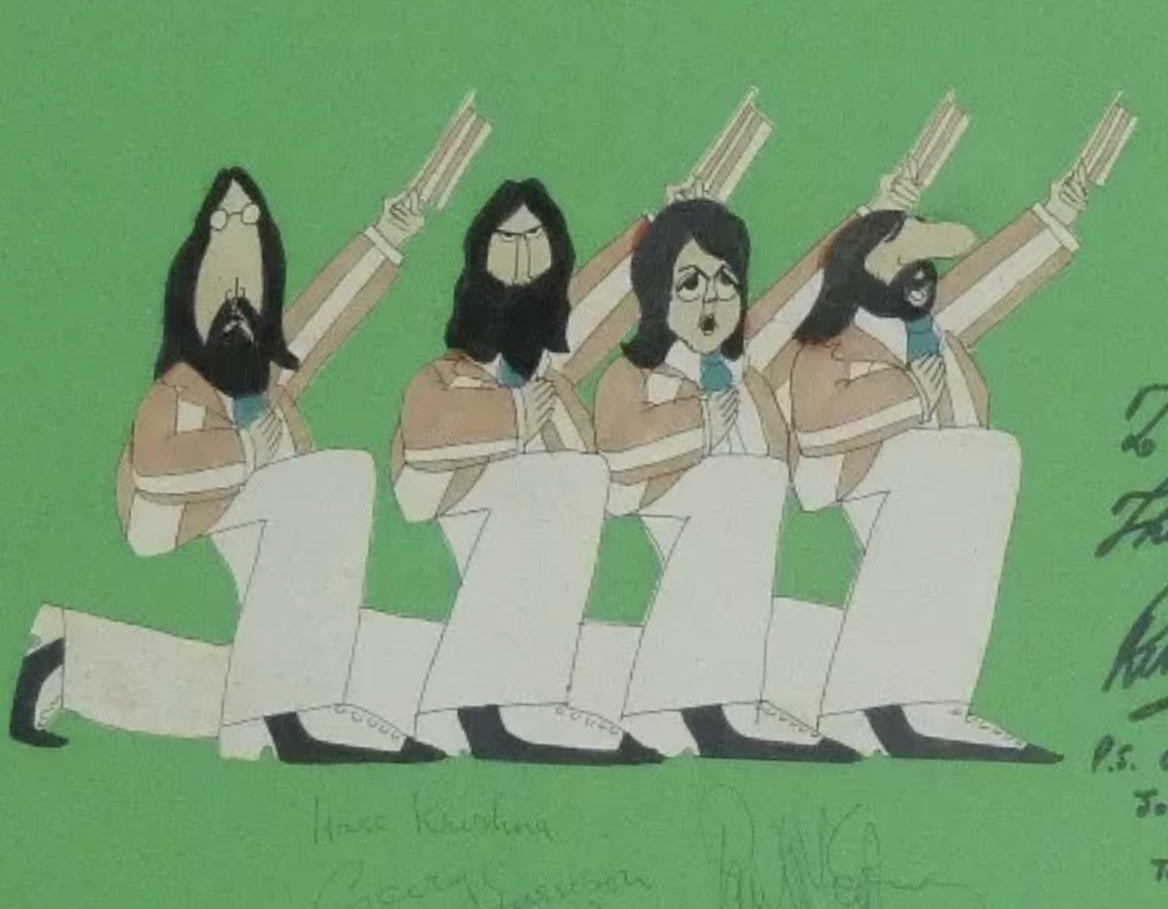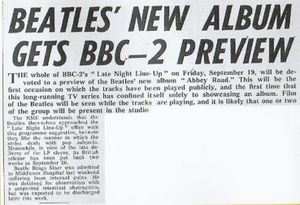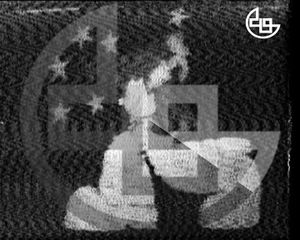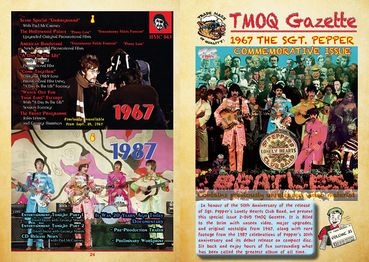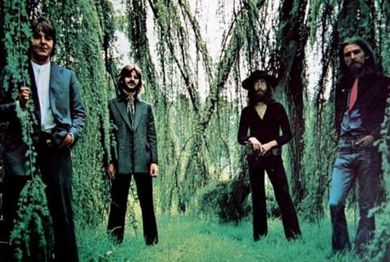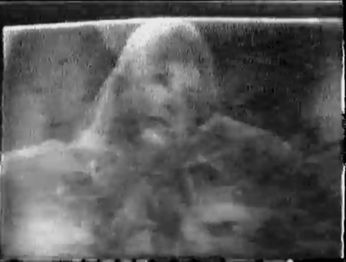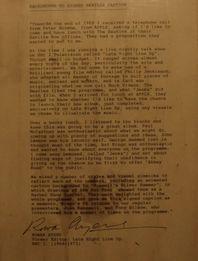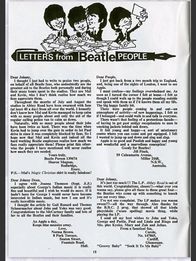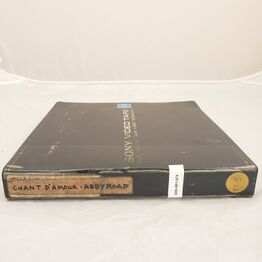Late Night Line-Up (partially found Beatles "Abbey Road" special; 1969)
An illustration of The Beatles used during the "Maxwell's Silver Hammer" sequence.
Status: Partially Found
Late Night Line-Up was a pioneering British television discussion program broadcast on BBC2 between 1964 and 1972. On Friday, September 19th, 1969, the program devoted an entire 33-minute show to highlight the then-upcoming Beatles album Abbey Road. The program featured short music videos featuring abridged versions of the album's songs. The program is significant for being the earliest known example of a pop/rock album being represented as a music video and being commissioned by The Beatles themselves as a visual representation of the Abbey Road album.
Production History
The special was produced in cooperation with The Beatles' company Apple Corps to promote their album Abbey Road, which was to be released the following week of the program's air-date.[1] "The Beatles approached us", the BBC told the Daily Mirror. "It seems they often watch the program and they like the way pop music has been covered visually." Rowan Ayers, the editor for Line-Up, said that he planned to "illustrate the music with captions, film sequences and electronic devices."
Ayers met with The Beatles at Apple Corps to discuss the project. According to Ayers's account of that meeting, although John Lennon was "laconic" and George Harrison seemed "lost in thought" it was Paul McCartney that showed enthusiasm for the show. Coming up with "plenty of suggestions and ideas" of the program. Ringo Starr too showed interest and asked Ayers questions about the production and its production crew[2] Rowan Ayers wrote a letter written to the buyer of an animation cell from the "Maxwell's Silver Hammer" animation. The letter titled "Background To The Signed Caption" detailed the making of the TV special. Ayers recalls "We had a fortnight's notice...and we used all kinds of devices, like captions and film, and the Beatles were wild about it.”[3] The program was directed by Granville Jenkins.
Airing
The program first aired in the U.K. on Friday, September 19th, at 10:55-11:30 pm on BBC2 in colour. Colour programing, at the time, was exclusive to BBC2, until the following November when BBC1 and ITV would begin colour transmissions. [4]. Although growing, by September 1969, the uptake of colour television was still small, with only 200,000 tv sets reported in the UK by the end of 1969. [5]
The program was repeated on Saturday, October 10th at 11:25-12:00 pm. To this date, the entire program has not surfaced, and it is believed, due to other episodes of the program being lost, that the master tapes have been wiped by the BBC.
Contemporary Reviews
On the day of the first screening, newspapers published reviews of the program. Two contemporary reports were more descriptive of the show's content than critical of the program itself. The Coventry Evening Telegraph said: "Many different kinds of visuals will be used including film, captions, studio elements and electronic color devices."[6] The Daily Mail's description was similar.[7]
In George Melly’s 1970 book Revolt Into Style. Melly was critical of the program:
The new puritan climate at the Television Centre (and Broadcasting House come to that) will allow pop music within limits, but seems totally against allowing any overt display of teenage revolt. Modified psychedelia is acceptable. The Late Night Line-Up show Colour Me Pop is a pretty, but rather than an empty exercise in this genre, and the film made to present the Beatles’ new LP Abbey Road was equally innocuous, but the ideas seem, for the moment at any rate, back under lock and key.
Shortly after the screening, a reader’s letter in the Beatles Monthly praising the special.
Discovered Footage
On October 20th, 2019, Steve Hoffman Forum user dormouse shared an uploaded video from Dig Media that contained what is believed to be 53 seconds of silent footage from the TV special. The footage is black and white and appears to be captured from a TV monitor. The same footage with audio was uploaded to Dig Media’s Twitter account.[8] It was relieved by Dig Media on their user account that the complete program was on that video. Footage containing audio was uploaded onto their Twitter account.[9]
The video shows the "Come Together" segment that has the song playing over the A Day In The Life promo video. The song crossfades into a still from the Beatles' final photo session which transitions into the "Something" segment. "Something" features a female dancer, superimposed psychedelic lighting and effects. DIG Media had the footage because they were administering the video library left by sixties’ counterculture figure Jack Henry Moore. The footage appears to be sourced from an off-air recording from one of the two BBC2 broadcasts.
On February 12th, 2020, Dig Media posted another still shot from their Twitter account from the "Silver Hammer" segment.[10]
In April 2020, DigMedia replied on the recovered footage's YouTube video to a question about the video's content. DigMedia said that they were still working on recovering the footage and that remaining footage was in need of "serious recovery". They also said that the restoration plans had been slowed down due to the COVID-19 outbreak.
On June 23, 2022, a represented from the now rebranded, Dig Media Archive posted an update about the special on the Steve Hoffman Music Forum's Beatles Abbey Road BBC2 TV special 1969 thread:
Hi guys,Just a quick heads up that we’re continuing to work on the Late Night Line-up video.
It takes a lot of resources – repairing tape, image enhancement and lots more. As well as running a not-for-profit business and working our way through thousands of other tapes. We’ll be posting a few more clips on Socials in the coming months. Thanks for your interest in this, it’s really appreciated. Any help you can give us in boosting our profile will really help with more engagement so hopefully we can share more material.
Thanks!
On the same day, a video was uploaded to the Dig Media Archive Facebook page, about the TV special.[11]
Dig Media Archive tape and DVD-R
The Sony V-35 1/2-inch videotape and a DVD-R dub was catalogued on Dig Media's website.
The details of the recording state it was recorded in the CV-2000 PAL format by pointing a video camera at the TV screen[12]. The tape box has a handwritten with "CHANT D'AMOUR - ABBY ROAD” in black pen. "CHANT D'AMOUR" referring to the French movie Un chant d'amour (Song of Love) (1950). Un chant d'amour has a running time of 26 minutes. The maximum running time for a CV-2000 V-32 tape was 1 hour[13], so it's possible that both programs could exist in a complete form on the same reel.
Content and program format
Contemporary reviews reported the special as being a mixture of stock footage, art-house films, dancers, animation and exclusive Beatles footage. The current existing footage found by Dig Media in the archive of Jack Henry Moore show the structure as being brief excerpts of songs following each other without external narration:
The Jack Henry Moore/Dig Media footage
- Still photo of the rear of the Abbey Road album sleeve
- Footage from the "A Day In The Life" video with the 1st verse of "Come Together" (22 secs)
- Crossfade to the Tittenhurst Park promotional photo of The Beatles
- Crossfade to a dancer in a studio with what appears to be coloured lights. (approx.20 secs before cutting out)
Although the footage uploaded by Dig Media show brief excerpts of songs, recollections of people how saw the program at the time say that the whole song was used.
Turntable links
There have also been some viewer recollections that claim the program began with a copy of the Abbey Road record spinning on a turntable and each song was linked by footage of the album playing on a turntable. Other viewers have dismissed the turntable footage claims.
Footage used
Through the research of Steve Hoffman Music Forum user dormouse posted a rundown of the sources for footage possibly used during the program based on BBC documentation :
- NASA: 6 stills (Moon and Earth)
- APPLE: 2 stills (unknown but possibly the rear cover and the Tittenhurst Park photo from 22 August 1969 that appear between "Come Together")
- "Moon Walk" (38ft 16mm) approx 1 minute - Pathe Film Library
- "Universe" (75ft 16mm) approx 2 minutes - National Film Board of Canada
- 150ft 16mm footage from Filmfinders Ltd
- 131ft 16mm footage from Henry Howard, Mitchell Monkhouse Associates
- "Gyromorphosis" (93ft 16mm) approx 2 minutes 40 secs – John Huntley, British Film Institute
- "Autumn Spectrum" (100ft 16mm) approx 2 minutes 45 secs – John Huntley, British Film Institute
- "OffOn" (123ft 16mm) approx 3 minutes 20 secs –Vaughan-Rogosin Films Ltd
There were also viewer reports of cut away footage of the album being played on a turntable in-between the songs.
The track listing of the segments
The correct order of songs is yet unknown. From the footage released by Dig Media, "Come Together" is followed by "Something", as it appears on the released Abbey Road album.
| Song Title | Appearance in program | Lost Status | Segment Description | Notes |
|---|---|---|---|---|
| Come Together | Confirmed | Found | Footage of the "A Day In The Life" recording sessions. Directed by Keith Green for the unproduced Sgt. Pepper's Lonely Hearts Club Band TV special. | Found by Dig Media Archives in 2019. |
| Something | Confirmed | Found | A dance number featuring dancer Jane London. | Found by Dig Media Archives in 2019. |
| Maxwell's Silver Hammer | Confirmed | Partly Found | Stills or animation(?) | One second of footage was recovered by Dig Media Archives. |
| Oh Darling! | Not used | N/A | N/A | Liner notes of the The 1967 Sgt. Pepper Commemorative Issue bootleg state this song was not used. |
| Octopus's Garden | Confrimed | Missing | It is assumed that silent era footage provided by Filmfinders Ltd and Henry Howard, Mitchell Monkhouse Associates was used. | Appearance confirmed by BBC documentation. |
| I Want You (She's So Heavy) | Conflicting reports | Missing/Unconfirmed | N/A | Liner notes of the The 1967 Sgt. Pepper Commemorative Issue bootleg state this song was not used. However, a fan diary entry from the time states seeing this song. This song is not listed in any BBC documentation. |
| Here Comes The Sun | Comfrimed | Missing | Footage from "OffOn" featuring a silhouetted figure (4.46 mins - 5:00 mins) was confirmed by a viewer of the program. | Confirmed by viewer report and inclusion in BBC documentation. |
| Because | Comfrimed | Missing | It was confirmed that stills copyrighted to NASA were used during the song. It's also possible that footage from documented film sources "Moonwalk" and "Universe" were also used. | Reportedly, footage from the BBC's moon landing coverage was used. |
| You Never Give Me Your Money | Comfrimed | Missing | Unknown | Appearance confirmed by BBC documentation. |
| Sun King | Comfrimed | Missing | Unknown | Appearance confirmed by BBC documentation. |
| Mean Mr Mustard | Comfrimed | Missing | Unknown | Appearance confirmed by BBC documentation. |
| Polythene Pam | Comfrimed | Missing | Unknown | Appearance confirmed by BBC documentation. |
| She Came In Through the Bathroom Window | Not used | N/A | N/A | Liner notes of the The 1967 Sgt. Pepper Commemorative Issue bootleg state this song was not used. Not mentioned in BBC documentation. |
| Golden Slumbers | Comfrimed | Missing | Unknown | Appearance confirmed by BBC documentation. |
| Carry That Weight | Comfrimed | Missing | Unknown | Appearance confirmed by BBC documentation. |
| The End | Not used | N/A | N/A | Not mentioned in BBC documentation. |
| Her Majesty | Not used | N/A | N/A | Not mentioned in BBC documentation. |
Additional information about song segments
Come Together
An edit collage of footage from the orchestral recording session of "A Day In The Life" on 10th February, 1967. The footage was originally planned to be used in an abandoned Sgt. Pepper's Lonely Hearts Club Band TV special planned for 1967. Although edited into what was meant to be the "A Day In The Life" segment, the completed sequence was never used and the idea of a TV special, later evolved into Magical Mystery Tour (which was released in the UK on BBC1 as a Boxing Day TV special).
The footage sat unused until the Late Night Line-Up Special. Apple Corps. sent the footage to the BBC to be used and "Come Together" replaced the audio of "A Day In The Life" (either by the show's producers or Apple themselves). The version of Come Together used is a unique mono mix that has never been commercially released.[14]
The footage with its original “A Day In The Life” soundtrack would later be used in the abandoned official documentary of the band’s career The Long And Winding Road in the 1970s. The documentary remained an incomplete work print until the project was rebooted in the 1990s as The Beatles Anthology.
A short clip of the footage would later appear publicly during the 3rd December 1982 edition of The Tube (Channel 4, UK). Since then, the complete "A Day In The Life" version has been featured in many documentaries on The Beatles, including the official John Lennon documentary Imagine: John Lennon (1988) and The Beatles' own The Beatles Anthology series (1995). It's also officially available in full on The Beatles 1+ (2015) promotional video compilation and on their official YouTube channel.
In 2017, the Come Together segment was released in full from a 16mm print on the TMOQ bootleg DVD The 1967 Sgt. Pepper Commemorative Issue.[15]
Something
After a transition from a photographic still (taken from the group's final photo session), the "Something" segment featured dancer Jane London. London danced to the song with psychedelic images superimposed over her. After the program aired, a different official promotional music video would later be created to promote the song's single by Apple Corps. This video would feature The Beatles themselves.
Maxwell's Silver Hammer
The "Maxwell's Silver Hammer" segment was said to be an animated short featuring Maxwell and The Beatles. The segment also featured a shot of an illustration of The Beatles (with their mid-1969 hairstyles and beards) dressed as a barbershop quartet. The heads of the illustration moved to emulate the group signing. This effect was achieved by the director by cutting out the heads, reattaching them to a pin and using a fan off-screen to make the head wobble.
The barbershop quartet drawing
In December 2004 a signed drawing from the "Maxwell's Silver Hammer” segment of the program was put up on eBay for $2.25m. The drawing was listed again on eBay for $1 million USD in October 2019. This time it ended with no bids. It included a typed letter from the editor of Late Night Line Up, Rowan Ayres detailing the history of the cell and the special.[16]
In April 2020, the drawing was listed again, this time with starting bid of $3.5 million. The description listed more information about its history:
THE LAST SIGNED ARTWORK BY THE BEATLES MAXWELLS SILVER HAMMER ONLY PIECE IN EXISTENCE
You MUST Message me before Bidding with full identification details, mobile number etc name or your bid will be immediately deleted, and you will be blocked.
This incredible piece of Historical signed Art was accepted for sale by Sotherbys but I did not agree to the terms of sale. The Beatles contacted me years ago showing an interest in buying this back even writing to me but I did not sell. This was arranged through their EMI agent Michael Heatley and the original of this letter also comes with this piece.
Sadly the split of the band has been captured uniquely and forever immortalised, John and Ringo signing in black marker and George and Paul in blue pen this incredible feature the split of the band has never been seen before or captured in such a way. The framers [sic] markings are on the back D.N 29/1 29th January 1970
The Iconic drawing of Maxwell's Silver Hammer created by John Lennon and signed by The Beatles is the only piece of actual memorabilia in existence from the launch of Abbey Road on BBC 2 show Late Night Line Up. It was signed and presented to Rowan Ayers in early February 1970 he was the Chief Editor and Producer of the show a pioneering 60s music and talk back television presentation. Argueably [sic] the last known autographs of the band quite large [sic] from 3 - 4 inches in length magnificently signed they surround the one of a kind hand drawn caricature which featured in the film clip for Maxwell's Silver Hammer. The caricature can only be described as ICONIC having been seen by millions world wide in late 1969 dancing and wobbling to the film clip created by Rock Video pioneer Phillip Jenkinson, the heads are separated from the bodies so they could wobble to Maxwell's Silver Hammer. The memento has featured in many magazines and newspaper articles since it's discovery in 1997 when I purchased it from Rowan Ayers and has been written about in books including the official biographer of The Beatles Hunter Davies and recently featured in a full colour spread by renown Beatles author Bruce Spizer. The caricature mistakingly [sic] called a cell in some internet websites is a one of a kind drawing by John Lennon and measures 26cm x 16cm. The original black framed historical piece has now been housed in a gold vintage frame and measures around 90cm x 80cm. Rowan has signed a typed story on the back on how he met The 4 Beatles for lunch to discuss the launch of Abbey Road. This is a virtually priceless piece of historical signed art of great importance and sadly is for sale though I have enjoyed owning it for many years. Should be a major draw card to any reputable museum. Buyer to pay Insurance fees or can arrange pick up from my lawyers [sic] office in Sydney.
Only 1 second of footage has so far been recovered from the Jack Henry Moore tape by DigMedia. A still of this frame was posted on their Twitter account. The frame shows a cartoon Maxwell swinging his arm that has a hammer as a hand. The Maxwell segment came after "Something" as it does on the Abbey Road album.
Video Gallery
Image Gallery
See Also (BBC Wiped Programs Media)
- 1953 British Grand Prix (partially found footage of Formula One race; 1953)
- Adam Adamant Lives! (partially lost BBC children's TV series; 1966)
- Anne of Green Gables (lost TV mini-series; 1972)
- Dad's Army (partially lost episodes and sketches; 1968-1970)
- Doctor Who (partially lost BBC sci-fi series episodes; 1963-1978)
- Jazz Goes to College (partially found BBC jazz concert series; 1966-1967)
- Madhouse on Castle Street (partially found BBC television play; 1963)
- Out of the Unknown (partially found BBC sci-fi series; 1967-1971)
- Requiem for a Heavyweight (partially found BBC Sunday-Night Theatre TV play; 1957)
- The Complete and Utter History of Britain (partially found British sketch comedy TV series; 1969)
- The Quatermass Experiment (partially found BBC sci-fi serials; 1953)
- The Sad Story of Henry (lost live BBC broadcast adaptation of "The Railway Series" books; 1953)
- United! (lost British soap opera; 1965-1967)
- Zingalong (partially found British children's series; 2002-2004)
See Also (The Beatles Media)
See Also
- The Beatles live at Stowe School, Buckinghamshire (found recording of British rock band concert; 1963)
- The Threetles (partially found unreleased recordings from Beatles reunion sessions; 1990s)
- The Long and Winding Road (found workprint of unfinished Beatles documentary; 1970s)
- Help! (partially found deleted scenes from The Beatles film; 1965)
- Revolution 1 (Take 20) (found mix of The Beatles song; 1968)
- The Beatles Cartoon (partially lost skits/bumpers of animated TV series; 1965-1967)
- Carnival of Light (lost experimental Beatles song; 1967)
- A Hard Day's Day - A Day in the Life of a Beatles Tribute Band (found parody film; 2002)
- The Beatles (partially found Cavern Club performance recordings of British rock band; early 1960s)
- Now and Then (found overdub session of Beatles song; 1995)
- Strawberry Fields (partially found production material from cancelled musical animated film; 1980s-1989)
- Yellow Submarine (partially lost production material for cancelled CGI remake of Beatles animated film; 2010-2011)
External Links
- The Vinyl Guide Episode 179: The Story of Abbey Road with Bruce Spizer. A podcast covering the history of the Abbey Road album that covers the special. Retrieved 21 Oct '19
- Wikipedia page on Late Night Line-Up. Retrieved 21 Oct '19
- The Telegraph Obituary page on Jack Henry Moore. Retrieved 21 Oct '19
- Beatles Abbey Road BBC2 TV special 1969 - Steve Hoffman Music Forums A thread covering updates on the special. Retrieved 12 Oct '21
- Dig Media Archive - the current home of Jack Henry Moore's videotape archive and the only known recording of the Abbey Road special.
- Dig Media Archive (Abbey Road) - the catalogued DVD-R of the special.
- Dig Media Archive (Chant D'Amour - Abby Road) - the catalogued videotape of the special.
References
- ↑ The Complete Beatles Chronicle, Mark Lewishon
- ↑ The Beatles Book, Hunter Davis, 2019, Ebury Press, ISBN: 978009158633
- ↑ Radio Times. 17th January 1970.
- ↑ https://www.scienceandmediamuseum.org.uk/objects-and-stories/history-colour-tv-uk#:~:text=Finally%2C%20on%201%20July%201967,German%20television%20engineer%20Walter%20Bruch. THE HISTORY OF COLOUR TV IN THE UK - Science and Media Museum
- ↑ https://www.scienceandmediamuseum.org.uk/objects-and-stories/history-colour-tv-uk#:~:text=In%20March%201969%2C%20there%20were,1972%20there%20were%201.6%20million.
- ↑ The Coventry Evening Telegraph, Friday, 19 September 1969
- ↑ The Daily Mail, Friday, 19 September 1969
- ↑ Dig Media’s Twitter post that has the footage with sound. Retrieved 21 Oct '19
- ↑ Dig Media Twitter post on the program. Retrieved 11 Oct '19
- ↑ Dig Media Twitter post on the program. Retrieved 21 Feb '20
- ↑ Dig Media Archive - Facebook page
- ↑ Abbey Road - DIG Media Archive http://toastedproductions.com/dig/items/show/2831 - DVD-R transfer from 2013.
- ↑ Sony CV Series Video (smecc.org)
- ↑ The 1967 Sgt. Pepper Commemorative Issue liner notes. Pages 8, 9, 10. TMOQ. Retrieved 15 July 2022
- ↑ Review of the TMOQ DVD set. Retrieved 21 Oct '19
- ↑ eBay listing for an animation cell from the "Maxwell's Silver Hammer" segment. Retrieved 21 Oct '19
